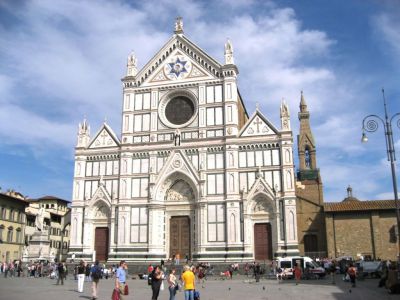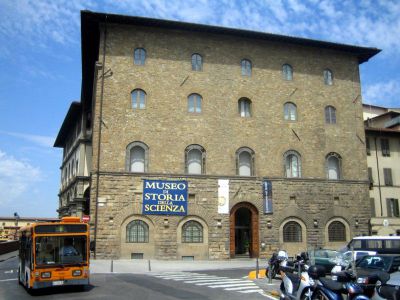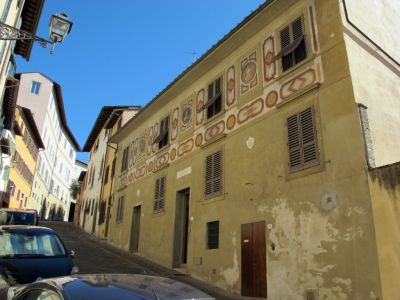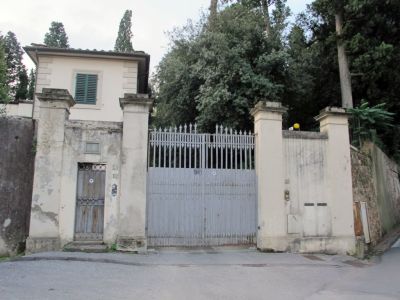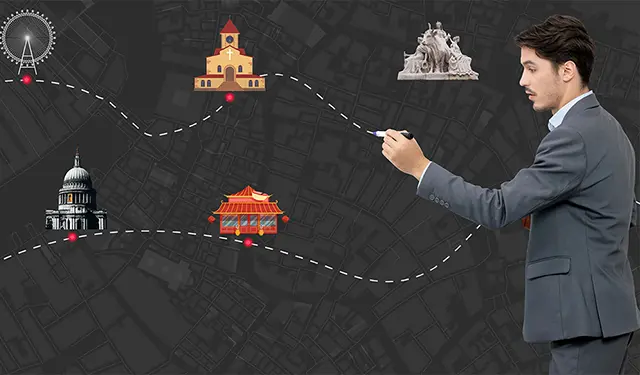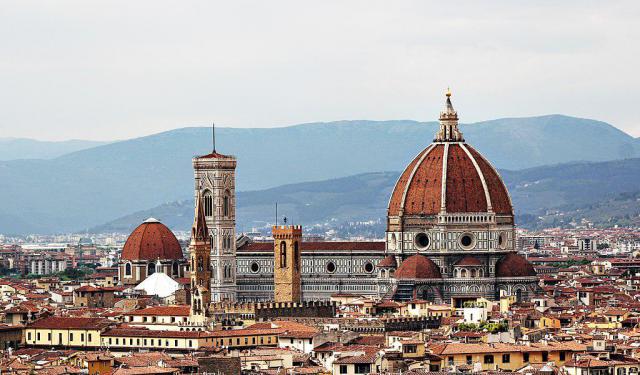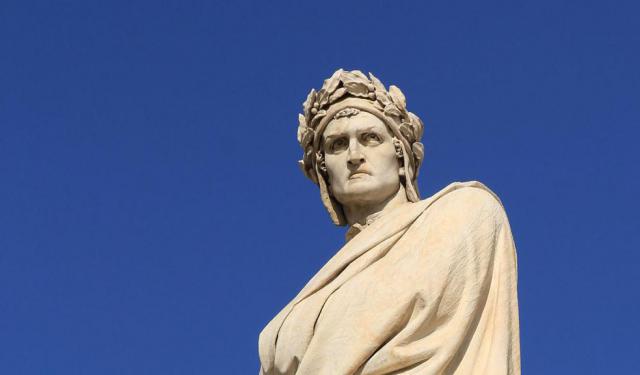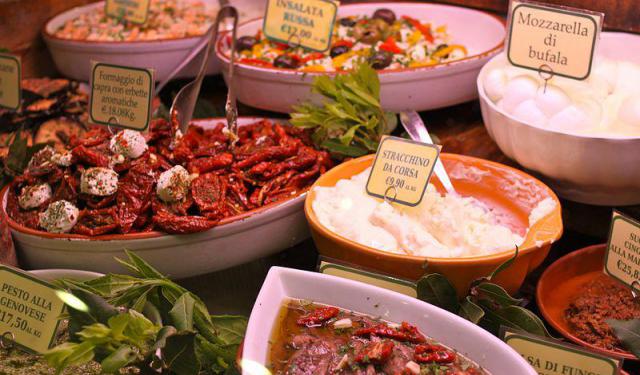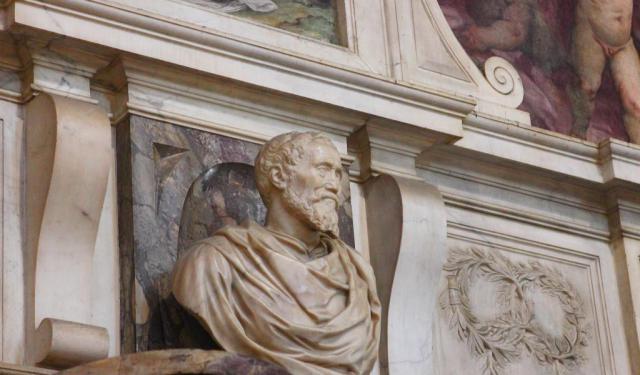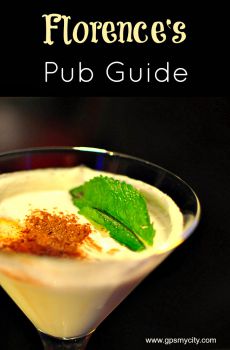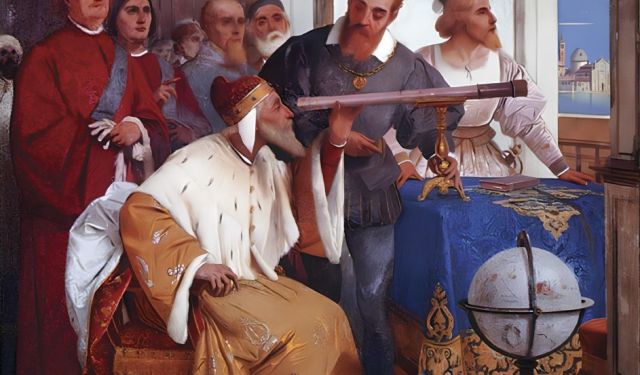
In Gelileo's Footsteps Walk (Self Guided), Florence
Galileo’s musician father Vincenzo was from Florence and moved back there when Galileo was a child (he’s buried there too), but Galileo Galilei himself was born in Pisa and attended the university there.
Galileo later lived in Padua where he had several children with his mistress Marina Gamba. Only in 1610 did he move to Florence, but his connections to the city are long and deep.
Galileo lived in several houses in and around Florence and I visit two of them, at least in passing. It’s in this great Renaissance city where he made many of his astronomical observations. Two of his daughters – Virginia and Livia - were cloistered nearby to become Suor Maria Celeste and Suor Arcangela.
Galileo was the first to use a telescope for serious astronomy and made numerous discoveries, including the four largest moons of Jupiter, the craters of the Moon, the phases of Venus, sunspots and much else besides.
Galileo was, of course, eventually tried for heresy in Rome due to his heliocentrism, but returned to Florence to live out his days under a kind of house arrest, cared for by his daughter and later his son’s family. ***PH***
Galileo later lived in Padua where he had several children with his mistress Marina Gamba. Only in 1610 did he move to Florence, but his connections to the city are long and deep.
Galileo lived in several houses in and around Florence and I visit two of them, at least in passing. It’s in this great Renaissance city where he made many of his astronomical observations. Two of his daughters – Virginia and Livia - were cloistered nearby to become Suor Maria Celeste and Suor Arcangela.
Galileo was the first to use a telescope for serious astronomy and made numerous discoveries, including the four largest moons of Jupiter, the craters of the Moon, the phases of Venus, sunspots and much else besides.
Galileo was, of course, eventually tried for heresy in Rome due to his heliocentrism, but returned to Florence to live out his days under a kind of house arrest, cared for by his daughter and later his son’s family. ***PH***
How it works: Download the app "GPSmyCity: Walks in 1K+ Cities" from Apple App Store or Google Play Store to your mobile phone or tablet. The app turns your mobile device into a personal tour guide and its built-in GPS navigation functions guide you from one tour stop to next. The app works offline, so no data plan is needed when traveling abroad.
In Gelileo's Footsteps Walk Map
Guide Name: In Gelileo's Footsteps Walk
Guide Location: Italy » Florence (See other walking tours in Florence)
Guide Type: Self-guided Walking Tour (Sightseeing)
# of Attractions: 5
Tour Duration: 2 Hour(s)
Travel Distance: 4.5 Km or 2.8 Miles
Author: greghasleft
Sight(s) Featured in This Guide:
Guide Location: Italy » Florence (See other walking tours in Florence)
Guide Type: Self-guided Walking Tour (Sightseeing)
# of Attractions: 5
Tour Duration: 2 Hour(s)
Travel Distance: 4.5 Km or 2.8 Miles
Author: greghasleft
Sight(s) Featured in This Guide:
- Basilica di Santa Croce (Basilica of the Holy Cross)
- Galleria degli Uffizi (Uffizi Gallery)
- Museo Galileo (Galileo Museum)
- House Galileo Galilei on Costa San Giorgio
- Villa dell’Ombrellino (Villa of the Little Umbrella)
1) Basilica di Santa Croce (Basilica of the Holy Cross) (must see)
One of the most renowned and largest Franciscan churches worldwide, Santa Croce was constructed in the 13th and 14th centuries, flaunting a rich Gothic style of architecture. Also known as the "Temple of the Italian Glories", it has the final resting places of numerous illustrious Italians, including Michelangelo, Galileo, Machiavelli, poet Foscolo, and composer Rossini.
Elaborate sculptures embellish the tombs, while paintings adorn the altar and walls. Some of the finest artisans, sculptors and painters have left their marks upon the church, which is sure to grip visitors with its grandeur and presence. Artists with work in the church include Giotto, Donatello, Giorgio Vasari, Domenico Veneziano, Antonio Canova, Cimabue, Benedetto da Maiano, Andrea and Luca della Robbia, Desiderio da Settignano, Giovanni da Milano, Maso di Banco, Agnolo and Taddeo Gaddi, Andrea Orcagna, Antonio Rossellino, Santi di Tito, and Henry Moore. Legend even has it that Santa Croce was founded by Saint Francis himself!
The surrounding grounds are equally enchanting, and the grassy inner courtyard, with its columns and statuary, invites visitors to explore and perhaps spend an entire day with a sketchbook. The exterior plaza hosts various events, ranging from concerts by visiting musicians to Florentine "rugby" matches.
***MICHELANGELO'S MASTERPIECES***
Despite Michelangelo's wishes, his body was transported from Rome to Florence, where Cosimo de' Medici and the artist/biographer Vasari organized an opulent funeral on March 10, 1564. Since de' Medici could not honor Michelangelo in Florence during his lifetime, he declared that he would pay homage to the artist in death, commissioning an elaborate tomb as a fitting tribute.
The monumental tomb inside the church – which ended up being a costly endeavor, taking 14 years to complete due to various delays – was commissioned to the same Vasari, who incorporated traditional symbols and imagery associated with Michelangelo. Adjacent to the artist's bust, three intertwined laurel wreaths symbolize the fusion of Painting, Sculpture, and Architecture, which are also depicted below as three muses mourning the loss of the great artist.
***DANTE'S FLORENCE WALK***
After years of efforts to repatriate Dante's remains to his birth city, Florence, his empty sarcophagus was eventually placed here. Rejected when he was alive, Dante now rests in his adopted city of Ravenna, despite Florence's posthumous forgiveness and acceptance of the exiled poet. In commemoration of the 600th anniversary of his birth, a monument of Dante was erected outside in Santa Croce Square, named after the basilica that overlooks it.
***IN GALILEO'S FOOTSTEPS WALK***
Galileo passed away in 1642 and was laid to rest in the Church of Santa Croce. His monumental tomb, however, wasn’t built until 1737, thanks to the support of his disciple Vincenzo Viviani, who is also interred there. Galileo’s daughter, Maria Celeste, is buried alongside him, although this fact is rarely highlighted. The tomb features two allegorical female figures on either side, symbolizing Astronomy and Geometry. Appropriately, it stands directly opposite the tomb of Michelangelo.
Tip:
Do not miss the Leather school located behind the church, where young apprentices learn the craft, and where you can purchase some fantastic handmade one-offs.
Remember to dress appropriately, with shorts below the knee and women's shoulders covered, as they strictly enforce the dress code, particularly for women regarding shorts.
Elaborate sculptures embellish the tombs, while paintings adorn the altar and walls. Some of the finest artisans, sculptors and painters have left their marks upon the church, which is sure to grip visitors with its grandeur and presence. Artists with work in the church include Giotto, Donatello, Giorgio Vasari, Domenico Veneziano, Antonio Canova, Cimabue, Benedetto da Maiano, Andrea and Luca della Robbia, Desiderio da Settignano, Giovanni da Milano, Maso di Banco, Agnolo and Taddeo Gaddi, Andrea Orcagna, Antonio Rossellino, Santi di Tito, and Henry Moore. Legend even has it that Santa Croce was founded by Saint Francis himself!
The surrounding grounds are equally enchanting, and the grassy inner courtyard, with its columns and statuary, invites visitors to explore and perhaps spend an entire day with a sketchbook. The exterior plaza hosts various events, ranging from concerts by visiting musicians to Florentine "rugby" matches.
***MICHELANGELO'S MASTERPIECES***
Despite Michelangelo's wishes, his body was transported from Rome to Florence, where Cosimo de' Medici and the artist/biographer Vasari organized an opulent funeral on March 10, 1564. Since de' Medici could not honor Michelangelo in Florence during his lifetime, he declared that he would pay homage to the artist in death, commissioning an elaborate tomb as a fitting tribute.
The monumental tomb inside the church – which ended up being a costly endeavor, taking 14 years to complete due to various delays – was commissioned to the same Vasari, who incorporated traditional symbols and imagery associated with Michelangelo. Adjacent to the artist's bust, three intertwined laurel wreaths symbolize the fusion of Painting, Sculpture, and Architecture, which are also depicted below as three muses mourning the loss of the great artist.
***DANTE'S FLORENCE WALK***
After years of efforts to repatriate Dante's remains to his birth city, Florence, his empty sarcophagus was eventually placed here. Rejected when he was alive, Dante now rests in his adopted city of Ravenna, despite Florence's posthumous forgiveness and acceptance of the exiled poet. In commemoration of the 600th anniversary of his birth, a monument of Dante was erected outside in Santa Croce Square, named after the basilica that overlooks it.
***IN GALILEO'S FOOTSTEPS WALK***
Galileo passed away in 1642 and was laid to rest in the Church of Santa Croce. His monumental tomb, however, wasn’t built until 1737, thanks to the support of his disciple Vincenzo Viviani, who is also interred there. Galileo’s daughter, Maria Celeste, is buried alongside him, although this fact is rarely highlighted. The tomb features two allegorical female figures on either side, symbolizing Astronomy and Geometry. Appropriately, it stands directly opposite the tomb of Michelangelo.
Tip:
Do not miss the Leather school located behind the church, where young apprentices learn the craft, and where you can purchase some fantastic handmade one-offs.
Remember to dress appropriately, with shorts below the knee and women's shoulders covered, as they strictly enforce the dress code, particularly for women regarding shorts.
2) Galleria degli Uffizi (Uffizi Gallery) (must see)
If you had to choose just one Renaissance location to visit in Florence, or even in the entire world, the most obvious and compelling choice would be the Uffizi Gallery. Housed in the Palazzo degli Uffizi, originally intended as the offices of magistrates (hence the name "uffizi"), this magnificent structure was constructed in the 16th century by Giorgio Vasari for Cosimo Medici, the first Duke of Florence. Not only did it serve as a governmental building, but it also became an ideal space to house the Medici family's remarkable art collection. Since 1765, the gallery has been open to the public and has grown to become one of Florence's most popular tourist attractions.
The displayed here must-see works of art include Sandro Botticelli's "Birth of Venus" and "Adoration of the Magi", not to mention the works of Leonardo da Vinci, Michelangelo, Caravaggio and other eternal greats. The collection is truly magnificent and it's easy to lose track of time while immersing oneself in its splendor.
While paintings and sculptures are the main draw for visitors, the gallery's interior decoration, particularly the intricate ceilings, is equally spectacular and deserves attention. With over 50 lavish rooms to explore, it can be challenging to absorb everything in one visit. Therefore, taking a break and recharging at the on-site café with a terrace is highly recommended. Among other delights, you'll be treated to unparalleled views that cannot be experienced elsewhere.
Due to its world-class status, the museum is perpetually bustling with visitors, and long queues, sometimes lasting hours, are not uncommon, especially during peak seasons. Those who book their tickets in advance through the official website enjoy a significantly shorter wait time and may even get discounted rates.
***FLORENCE PALACES WALK***
The Uffizi's internal courtyard is a long and narrow space that opens towards the Arno River through a Doric screen. This unique architectural feature, which allows for an uninterrupted view, is considered by historians as the first standardized streetscape in Europe. Vasari, who was both a painter and an architect, accentuated the perspective length of the courtyard by adorning it with the matching facades' continuous roof cornices, unbroken cornices between storeys, and the three continuous steps on which the palace-fronts stand. In the 19th century, niches in the piers alternating with columns of the Loggiato were filled with sculptures of famous artists.
***MICHELANGELO'S MASTERPIECES***
During the first eight years of the 1500s, Michelangelo not only sculpted his iconic "David" and the "Bruges Madonna" but also chiseled seven additional sculptures and four smaller statues for an altar. He also accepted painting commissions, and one of his works displayed in the Uffizi is the "Doni Tondo" ("Holy Family"), completed in 1504. This round-shaped painting, nearly four feet in diameter, vividly portrays the Virgin Mary, the Christ Child, and St. Joseph. The juxtaposition of vibrant colors in this artwork foreshadows Michelangelo's later use of color in his renowned frescoes on the Sistine Ceiling.
It is argued that Michelangelo used this painting to defend the Maculist perspective, a philosophy of the Dominican order that rejects the concept of the Immaculate Conception of Mary. According to the Maculist view, Mary's sanctification occurred at the moment of Christ's incarnation, rather than at her birth. Thus, the image depicts the moment of Mary's sanctification, as the Christ Child blesses her. Michelangelo portrays Christ as if he is emerging from Mary's shoulder to take human form, with one leg hanging limply and the other not visible, emphasizing his integration with Mary.
Tip:
If you decide to visit, please note that no liquids are permitted on the premises. You may consider arriving an hour or two before closing time to obtain a ticket without having to wait in line. Good luck!
The displayed here must-see works of art include Sandro Botticelli's "Birth of Venus" and "Adoration of the Magi", not to mention the works of Leonardo da Vinci, Michelangelo, Caravaggio and other eternal greats. The collection is truly magnificent and it's easy to lose track of time while immersing oneself in its splendor.
While paintings and sculptures are the main draw for visitors, the gallery's interior decoration, particularly the intricate ceilings, is equally spectacular and deserves attention. With over 50 lavish rooms to explore, it can be challenging to absorb everything in one visit. Therefore, taking a break and recharging at the on-site café with a terrace is highly recommended. Among other delights, you'll be treated to unparalleled views that cannot be experienced elsewhere.
Due to its world-class status, the museum is perpetually bustling with visitors, and long queues, sometimes lasting hours, are not uncommon, especially during peak seasons. Those who book their tickets in advance through the official website enjoy a significantly shorter wait time and may even get discounted rates.
***FLORENCE PALACES WALK***
The Uffizi's internal courtyard is a long and narrow space that opens towards the Arno River through a Doric screen. This unique architectural feature, which allows for an uninterrupted view, is considered by historians as the first standardized streetscape in Europe. Vasari, who was both a painter and an architect, accentuated the perspective length of the courtyard by adorning it with the matching facades' continuous roof cornices, unbroken cornices between storeys, and the three continuous steps on which the palace-fronts stand. In the 19th century, niches in the piers alternating with columns of the Loggiato were filled with sculptures of famous artists.
***MICHELANGELO'S MASTERPIECES***
During the first eight years of the 1500s, Michelangelo not only sculpted his iconic "David" and the "Bruges Madonna" but also chiseled seven additional sculptures and four smaller statues for an altar. He also accepted painting commissions, and one of his works displayed in the Uffizi is the "Doni Tondo" ("Holy Family"), completed in 1504. This round-shaped painting, nearly four feet in diameter, vividly portrays the Virgin Mary, the Christ Child, and St. Joseph. The juxtaposition of vibrant colors in this artwork foreshadows Michelangelo's later use of color in his renowned frescoes on the Sistine Ceiling.
It is argued that Michelangelo used this painting to defend the Maculist perspective, a philosophy of the Dominican order that rejects the concept of the Immaculate Conception of Mary. According to the Maculist view, Mary's sanctification occurred at the moment of Christ's incarnation, rather than at her birth. Thus, the image depicts the moment of Mary's sanctification, as the Christ Child blesses her. Michelangelo portrays Christ as if he is emerging from Mary's shoulder to take human form, with one leg hanging limply and the other not visible, emphasizing his integration with Mary.
Tip:
If you decide to visit, please note that no liquids are permitted on the premises. You may consider arriving an hour or two before closing time to obtain a ticket without having to wait in line. Good luck!
3) Museo Galileo (Galileo Museum)
This museum serves as a remarkable tribute to the renowned scientist Galileo Galilei, who was born in Pisa in 1564 and passed away in 1642. Within its walls, visitors can explore a fascinating collection that includes Galileo's telescopes and the lens he utilized to make groundbreaking discoveries about Jupiter's largest moons. The museum also offers impressive, large-scale reconstructions of Galileo's experiments on motion, weight, velocity, and acceleration, occasionally demonstrated by knowledgeable staff members.
In 1657, Florence established the world's first-ever scientific institution, the Academy for Experimentation ("Accademia del Cimento"), as a tribute to Galileo. Some of the academy's pioneering inventions, such as early thermometers, hygrometers, and barometers, are proudly showcased in the museum.
Additionally, be sure to admire the 1554 world map created by Portuguese cartographer Lopo Homem, as well as the nautical instruments devised by Sir Robert Dudley, an Elizabethan marine engineer employed by the Medici dukes to construct the harbor at Livorno.
Why You Should Visit:
Visitors with an interest in English literature will have the opportunity to expand their knowledge, while art enthusiasts can appreciate the aesthetic beauty of thes functional devices on display. Engineers will find themselves in a paradise of endless arrays of gadgets. Families with young children seeking a hands-on experience may not find it here, but students of all ages will find this museum to be enriching. Furthermore, admission grants access to one of the marvels of modern science: air-conditioning.
In 1657, Florence established the world's first-ever scientific institution, the Academy for Experimentation ("Accademia del Cimento"), as a tribute to Galileo. Some of the academy's pioneering inventions, such as early thermometers, hygrometers, and barometers, are proudly showcased in the museum.
Additionally, be sure to admire the 1554 world map created by Portuguese cartographer Lopo Homem, as well as the nautical instruments devised by Sir Robert Dudley, an Elizabethan marine engineer employed by the Medici dukes to construct the harbor at Livorno.
Why You Should Visit:
Visitors with an interest in English literature will have the opportunity to expand their knowledge, while art enthusiasts can appreciate the aesthetic beauty of thes functional devices on display. Engineers will find themselves in a paradise of endless arrays of gadgets. Families with young children seeking a hands-on experience may not find it here, but students of all ages will find this museum to be enriching. Furthermore, admission grants access to one of the marvels of modern science: air-conditioning.
4) House Galileo Galilei on Costa San Giorgio
The House of Galileo Galilei on Costa San Giorgio in Florence is a notable historical residence believed to have once belonged to the famed astronomer and physicist. Nestled in the Oltrarno district, this house is part of a cluster of properties acquired by the Galilei family between 1629 and 1634. Galileo himself is recorded to have purchased the house on August 18, 1634, from Jacopo Zuccagni. However, ownership was contested by Zuccagni, who refused to acknowledge Galileo’s possession until a decision was made by the Supreme Magistrate.
The home is easily identifiable thanks to its decorative facade, which features a coat of arms of the Galilei family and a frescoed medallion portrait of Galileo, as well as a commemorative marble plaque marking a visit from Grand Duke Ferdinand II. Adding to the property’s historical value, a sundial attributed to Galileo himself still exists on the rear facade of the building. Installed around 1620, this timekeeping instrument reflects Galileo’s keen interest in astronomical tools and measurements.
Although the scientist is more famously associated with his later residence, Villa Il Gioiello in Arcetri, the Costa San Giorgio house carries deep historical resonance, particularly for those interested in his Florentine years and family life.
One fascinating anecdote tied to the house dates back to May 1633, during a time when the plague was sweeping through Florence. In a bid to protect the city, the revered image of the Madonna of Impruneta was carried in a solemn procession through the streets. Galileo’s house was decorated for the occasion with an elaborate altar inside the doorway and an original fountain, so striking that it was believed to be one of his inventions. Interestingly, at this very time, Galileo was in Rome, facing the Inquisition in a trial that would ultimately lead to his condemnation.
The home is easily identifiable thanks to its decorative facade, which features a coat of arms of the Galilei family and a frescoed medallion portrait of Galileo, as well as a commemorative marble plaque marking a visit from Grand Duke Ferdinand II. Adding to the property’s historical value, a sundial attributed to Galileo himself still exists on the rear facade of the building. Installed around 1620, this timekeeping instrument reflects Galileo’s keen interest in astronomical tools and measurements.
Although the scientist is more famously associated with his later residence, Villa Il Gioiello in Arcetri, the Costa San Giorgio house carries deep historical resonance, particularly for those interested in his Florentine years and family life.
One fascinating anecdote tied to the house dates back to May 1633, during a time when the plague was sweeping through Florence. In a bid to protect the city, the revered image of the Madonna of Impruneta was carried in a solemn procession through the streets. Galileo’s house was decorated for the occasion with an elaborate altar inside the doorway and an original fountain, so striking that it was believed to be one of his inventions. Interestingly, at this very time, Galileo was in Rome, facing the Inquisition in a trial that would ultimately lead to his condemnation.
5) Villa dell’Ombrellino (Villa of the Little Umbrella)
Perched on the scenic heights of Bellosguardo, Villa of the Little Umbrella is a historic residence just outside Florence, known for its sweeping views, lush gardens, and rich intellectual and cultural legacy. Originally built in 1372, the villa was home to the Segni family for over four centuries, including the historian Bernardo Segni. It was during the early 17th century, however, that the villa found a notable tenant—Galileo Galilei. From 1617 to 1631, the renowned scientist lived here, preferring the hilltop quiet over the bustle of Florence. It was at Villa di Bellosguardo, as it was then known, that Galileo worked on The Assayer and his groundbreaking Dialogue Concerning the Chief World Systems.
During his residence, Galileo conducted astronomical observations, particularly on the motions of Jupiter’s satellites—known as the Medicean planets—and collaborated with fellow scientist Benedetto Castelli. These years marked a period of intense scientific activity and innovation, preceding Galileo’s final relocation to Arcetri. The villa thus remains a significant location in the history of science, serving as the backdrop for some of the astronomer’s most critical theoretical developments.
In 1815, the villa underwent a transformation under Countess Teresa Spinelli Albizi, who added an ornate iron pavilion shaped like a Chinese umbrella to the garden terrace. This decorative feature gave the villa its current name—Villa of the Little Umbrella. Later, in 1874, the Russian statesman Alexei Zubov acquired the estate and merged it with the adjacent Villa Torricella, redesigning the landscape into a vast romantic park filled with exotic plants such as palm trees, bamboo, and ginkgo biloba.
By the 20th century, the garden facing Florence was reimagined as an Italian-style garden by Cecil Pinsent, a British architect known for shaping some of Tuscany’s most refined green spaces. The villa gained further notoriety in the early 1900s as the home of Alice Keppel, a well-known figure in Edwardian society, and later her daughter Violet Trefusis, a writer and socialite.
During his residence, Galileo conducted astronomical observations, particularly on the motions of Jupiter’s satellites—known as the Medicean planets—and collaborated with fellow scientist Benedetto Castelli. These years marked a period of intense scientific activity and innovation, preceding Galileo’s final relocation to Arcetri. The villa thus remains a significant location in the history of science, serving as the backdrop for some of the astronomer’s most critical theoretical developments.
In 1815, the villa underwent a transformation under Countess Teresa Spinelli Albizi, who added an ornate iron pavilion shaped like a Chinese umbrella to the garden terrace. This decorative feature gave the villa its current name—Villa of the Little Umbrella. Later, in 1874, the Russian statesman Alexei Zubov acquired the estate and merged it with the adjacent Villa Torricella, redesigning the landscape into a vast romantic park filled with exotic plants such as palm trees, bamboo, and ginkgo biloba.
By the 20th century, the garden facing Florence was reimagined as an Italian-style garden by Cecil Pinsent, a British architect known for shaping some of Tuscany’s most refined green spaces. The villa gained further notoriety in the early 1900s as the home of Alice Keppel, a well-known figure in Edwardian society, and later her daughter Violet Trefusis, a writer and socialite.
Walking Tours in Florence, Italy
Create Your Own Walk in Florence
Creating your own self-guided walk in Florence is easy and fun. Choose the city attractions that you want to see and a walk route map will be created just for you. You can even set your hotel as the start point of the walk.
Florence Introduction Walking Tour
Florence was founded in 59 BC by Julius Caesar as a settlement for his veteran soldiers. Laid out like a Roman military camp, its main roads intersected at what is now the Republic Square. Originally named Fluentia, referencing its location between two rivers, the city later adopted the name Florentia, meaning “flowering” or “flourishing”.
And flourish it did. During the Middle Ages and... view more
Tour Duration: 2 Hour(s)
Travel Distance: 4.1 Km or 2.5 Miles
And flourish it did. During the Middle Ages and... view more
Tour Duration: 2 Hour(s)
Travel Distance: 4.1 Km or 2.5 Miles
Dante's Florence Walking Tour
Dante Alighieri was arguably the greatest – albeit also most controversial – of Italy's poets. After having served as one of the six priors governing Florence, his political activities – including the banishing of several rivals – led to his own banishment, upon which he wrote his masterpiece, “The Divine Comedy”, as a wanderer, seeking protection for his family in one town after... view more
Tour Duration: 1 Hour(s)
Travel Distance: 2.1 Km or 1.3 Miles
Tour Duration: 1 Hour(s)
Travel Distance: 2.1 Km or 1.3 Miles
Florence Food Tour
Food is one of the great Florentine passions, and the great thing about having a delicious authentic Tuscan meal, a snack, delicatessen, or a quality gelato here – besides the abundant variety – is not having to spend a lot of money for it.
In general, the “osterias” and the eateries nestled in Sant’Ambrogio Market will offer cheaper and more casual food with an emphasis on home... view more
Tour Duration: 2 Hour(s)
Travel Distance: 2.6 Km or 1.6 Miles
In general, the “osterias” and the eateries nestled in Sant’Ambrogio Market will offer cheaper and more casual food with an emphasis on home... view more
Tour Duration: 2 Hour(s)
Travel Distance: 2.6 Km or 1.6 Miles
Michelangelo's Masterpieces Walking Tour
Michelangelo spent over 20 years of his life in Florence – the birthplace of the Renaissance – during which time he created some of the most beautiful masterpieces the city had ever seen. The most famous of them – the David – was larger than life, and brought a larger-than-life image to the artist. No amount of photos or copies of the statue will do it justice, so to see it with your own... view more
Tour Duration: 2 Hour(s)
Travel Distance: 4.0 Km or 2.5 Miles
Tour Duration: 2 Hour(s)
Travel Distance: 4.0 Km or 2.5 Miles
Arno South Bank Walking Tour
The area south of Arno river, also called Oltrarno ("Beyond the Arno"), is a quieter place but not less interesting. Here you can find the Pitti Palace whose collection of paintings is second only to the Uffizi, and the vast Boboli Gardens once enjoyed by the Medici and the royal family. One of the first and most important examples of "Italian Gardens", they later served as... view more
Tour Duration: 2 Hour(s)
Travel Distance: 2.4 Km or 1.5 Miles
Tour Duration: 2 Hour(s)
Travel Distance: 2.4 Km or 1.5 Miles
Florence's Hidden Art Treasures
The “Cradle of the Renaissance,” Florence is one of Europe’s most beautiful and busiest destinations, home to some of the world's greatest pieces of art and architecture. The iconic masters like Giotto, Botticelli, Raphael and Michelangelo, as well as their somewhat less-known but equally talented counterparts, such as Ghirlandaio, Sangallo and Castagno, have blessed this city with... view more
Tour Duration: 2 Hour(s)
Travel Distance: 3.2 Km or 2 Miles
Tour Duration: 2 Hour(s)
Travel Distance: 3.2 Km or 2 Miles
Useful Travel Guides for Planning Your Trip
Souvenir Shopping Guide: 16 Unique Products to Buy in Florence
Compared to other Italian "grands" like Rome, Venice, or Milan, Florence is relatively less-known to an outsider for any local products, save, perhaps, Florentine mosaics and Fiorentina FC. Fortunately, there are tonnes of locally-originated things that this Italian city is rightfully...
Top 14 Pubs in Florence
Florence, the city of art and beauty has no problem in mastering the art of the nightlife as well. Local pubs are very popular and appreciated among the Florentines and the tourists. Locals and native English speakers that study or live in the city cannot wait to welcome tourists in their cozy...
Florence's Tasty Coffee Shop Guide
The caffe scene throughout Italy is an important factor of everyday life. People will pop in to their favorite bar on their way to work for a quick espresso breakfast with a pastry, they’ll grab a slice of pizza for lunch or drop by for an aperitivo before dining out and take a peaceful digestivo...
The Most Popular Cities
/ view all
